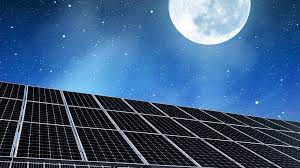Solar arrays generating miniscule amounts of power overnight could still charge up mobile phones during the hours of darkness, an experiment at Stanford University has indicated.
Cold, not light, – and in particular the temperature difference of panels chilling under starry clear skies – is the energy source of a generation innovation pioneered by Stanford University’s Dr Shanhui Fan.
Adding a thermoelectric generator – a device which produces currents from temperature differences – was key among modifications made by the Stanford team to a conventional PV module.
Disclosing his methods in an early April issue of the New Scientist, checked very carefully for its date, Dr Fan explained that the solar panel made a very efficient thermal radiator.
Lunar module
“At night, the solar panel can actually reach a temperature that’s below the ambient air temperature, and that’s a rather unusual opportunity for power harvesting”, Fan told the periodical.
In hours of darkness panels radiate heat out into space, where temperatures drop to a distinctly parky minus 270 degrees Celsius.
Hooked up through the heat exchanger, the modified solar cell generated a electrical output of 50 milliwatts per square metre.
Though a trifling 0.04 per cent of the cell’s daytime rating, the academic claimed 50 milliwatts per square metre would enable low-power devices like a low-wattage LED light or a phone charger, to pass current. In some circumstances, power storage devices would not be needed.
“Batteries can be expensive and temperamental”, opined the Californian academic, seeking light, not heat.
“They also require a lot of energy to manufacture, and can contribute to water and air pollution if improperly disposed of”.
The Stanford researcher told the magazine that he and his team see no intrinsic difficulties in the way of scaling the system up to a commercial product.
Materials researcher: “Chill out, dud”
Liverpool University’s Professor Ken Durose said applications for the technique would be limited to low-power tasks on arrays far from connected grids. “The potential for large-scale power generation through such means is therefore very low,” Durose told the New Scientist.
The paper by Dr Fan et al, appears in Applied Physics Letters.




